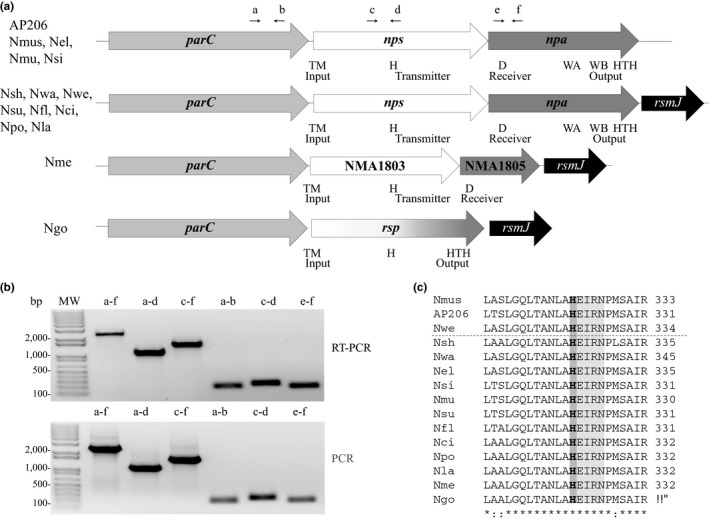Figure 1.

The nps‐npa operon in Neisseria species. (a) The nps‐npa locus in commensal Neisseria, and the analogous locus in pathogens Nme and Ngo. The small black arrows above the genes indicate the binding site of the primers used in the study (b). a, primer MR295, b, primer MR297; c, primer MR299; d, primer MR300; e, primer MR298; f, primer MR296. H, histidine, D, aspartate, WA, walker box A, WB, walker box B, HTH, Helix‐turn‐helix. (b) Top panel: Right three lanes: parC to npa, parC‐nps, and nps‐npa transcripts. Left three lanes: parC, nps and npa transcripts. All transcripts were produced by RT‐PCR using primers shown in (a). Bottom panel: Right three lanes: parC to npa, parC‐nps, and nps‐npa amplicons. Left three lanes: parC, nps and npa amplicons. All amplicons were produced by PCR using primers shown in (a). MW, molecular weight markers. (c) Alignment of the H phosphotransfer domain in Nps from Neisseria species. The phosphorylatable histidine is in bold type and boxed in dark gray. The canonical phosphatase motif (ExxN) in Pseudomonas aeruginosa PilS that is present in the Nps homolog is boxed in light gray. The dashed line separates Nps in animal and human Neisseria. (*) identical residues; (:) highly conserved residues. SAM, S‐adenosyl methyl transferase; Nmus, N. musculi; AP206, Neisseria sp isolated from rhesus macaque; Nwe, N. weaveri; Nsh, N. shayeganii; Nwa, N. wadsworthii; Nel, N. elongata; Nmu, N. mucosa; Nsi, N. sicca; Nsu, N. subflava; Nfl, N. flavescens; Nci, N. cinerea; Npo, N. polysaccharea; Nla, N. lactamica; Nme, N. meningitidis; Ngo, N. gonorrhoeae
